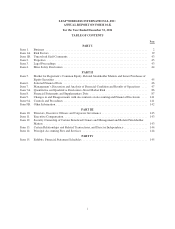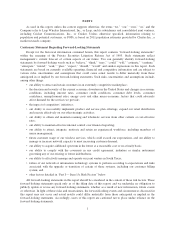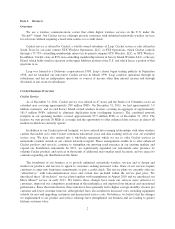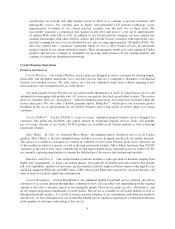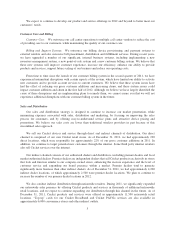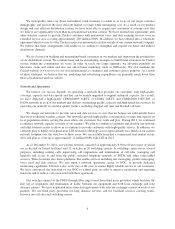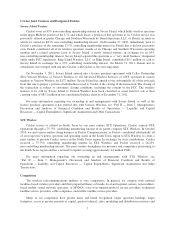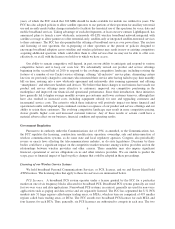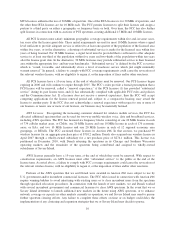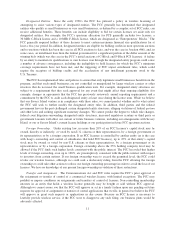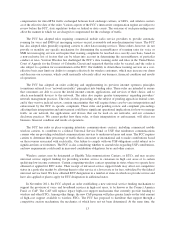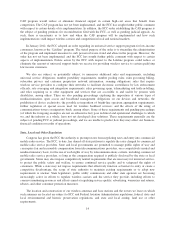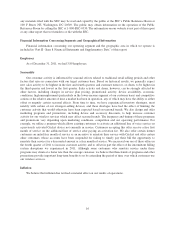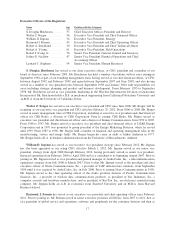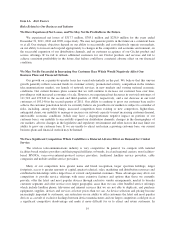Cricket Wireless 2011 Annual Report Download - page 19
Download and view the complete annual report
Please find page 19 of the 2011 Cricket Wireless annual report below. You can navigate through the pages in the report by either clicking on the pages listed below, or by using the keyword search tool below to find specific information within the annual report.years, of which the FCC stated that 300 MHz should be made available for mobile use within five years. The
FCC has also adopted policies to allow satellite operators to use portions of their spectrum for ancillary terrestrial
use and recently made further changes intended to facilitate the terrestrial use of this spectrum for voice, data and
mobile broadband services. Taking advantage of such developments, at least one new entrant, LightSquared, has
announced plans to launch a new wholesale, nationwide 4G-LTE wireless broadband network integrated with
satellite coverage to allow partners to offer terrestrial-only, satellite-only or integrated satellite-terrestrial services
to their customers. The FCC has also permitted the offering of broadband services over power lines. The auction
and licensing of new spectrum, the re-purposing of other spectrum or the pursuit of policies designed to
encourage broadband adoption across wireline and wireless platforms may result in new or existing competitors
acquiring additional spectrum, which could allow them to offer services that we may not be able to offer cost-
effectively, or at all, with the licenses we hold or to which we have access.
Our ability to remain competitive will depend, in part, on our ability to anticipate and respond to various
competitive factors and to keep our costs low. We substantially revised our product and service offerings
beginning in the second half of 2010 to respond to the evolving competitive landscape, including revising the
features of a number of our Cricket service offerings, offering “all-inclusive” service plans, eliminating certain
late fees we previously charged to customers who reinstated their service after having failed to pay their monthly
bill on time, entering into a new wholesale agreement and nationwide data roaming agreement and offering
“smartphones” and other new handsets and devices. We believe that these changes to our business have made our
product and service offerings more attractive to customers, improved our competitive positioning in the
marketplace and improved our financial and operational performance. Since their introduction, these initiatives
have generally led to higher average monthly revenue per customer and lower customer turnover, although they
have also resulted in increased costs, including equipment subsidy for new and upgrading customers and
incremental service costs. The extent to which these initiatives will positively impact our future financial and
operational results will depend upon continued customer acceptance of our product and service offerings and our
ability to retain these customers. The evolving competitive landscape may result in more competitive pricing,
slower growth, higher costs and increased customer turnover. Any of these results or actions could have a
material adverse effect on our business, financial condition and operating results.
Government Regulation
Pursuant to its authority under the Communications Act of 1934, as amended, or the Communications Act,
the FCC regulates the licensing, construction, modification, operation, ownership, sale and interconnection of
wireless communications systems, as do some state and local regulatory agencies. Congress also periodically
revises or enacts laws affecting the telecommunications industry, as do state legislatures. Decisions by these
bodies could have a significant impact on the competitive market structure among wireless providers and on the
relationships between wireless providers and other carriers. These mandates may also impose significant
financial, operational or service obligations on us and other wireless providers. We are unable to predict the
scope, pace or financial impact of legal or policy changes that could be adopted in these proceedings.
Licensing of our Wireless Service Systems
We hold broadband Personal Communications Services, or PCS, licenses, and we and Savary Island hold
AWS licenses. The licensing rules that apply to these two services are summarized below.
PCS Licenses. A broadband PCS system operates under a license granted by the FCC for a particular
market on one of six frequency blocks allocated for broadband PCS. Broadband PCS systems generally are used
for two-way voice and data applications. Narrowband PCS systems, in contrast, generally are used for non-voice
applications such as paging and data service and are separately licensed. The FCC has segmented the U.S. PCS
markets into 51 large regions called major trading areas, or MTAs, which in turn are comprised of 493 smaller
regions called basic trading areas, or BTAs. The FCC awards two broadband PCS licenses for each MTA and
four licenses for each BTA. Thus, generally, six PCS licensees are authorized to compete in each area. The two
9


